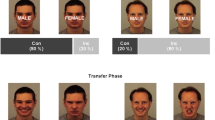Abstract
Humans cope with cognitive conflict in various ways, such as focusing on task-relevant instead of task-irrelevant information or avoiding situations where conflict is likely. These adaptations to conflict resemble those used to cope with negative affect. We examined whether situation modification, a strategy derived from the extended process model of emotion regulation, may influence responding in cognitive conflict tasks. This should be evident by a facilitation of actions that consistently modify situations towards congruent (positive) situations rather than to incongruent (negative) situations. In four experiments, participants modified stimuli in a color-word Stroop task towards congruent or incongruent stimuli of (un)predictable identity. A modification effect emerged insofar as participants were faster when they foreseeably produced congruent stimuli of predictable identity than when they produced incongruent stimuli or stimuli of unpredictable identity. Our results add to the body of evidence connecting affect and cognitive conflict, and reveal a constraint when using situation modification as a means to regulate cognitive conflict.





Similar content being viewed by others
References
Beckers, T., De Houwer, J., & Eelen, P. (2002). Automatic integration of non-perceptual action effect features: the case of the associative affective Simon effect. Psychological Research, 66(3), 166–173.
Botvinick, M. (2007). Conflict monitoring and decision making: reconciling two perspectives on anterior cingulate function. Cognitive, Affective & Behavioral Neuroscience, 7, 356–366.
Braem, S., & Trapp, S. (2017). Humans show a higher preference for stimuli that are predictive relative to those that are predictable. Psychological Research. Advance online publication. https://doi.org/10.1007/s00426-017-0935-x.
Chetverikov, A., & Kristjánsson, Á (2016). On the joys of perceiving: Affect as feedback for perceptual predictions. Acta Psychologica, 169, 1–10.
Dignath, D., & Eder, A. B. (2015). Stimulus conflict triggers behavioral avoidance. Cognitive, Affective, & Behavioral Neuroscience, 15(4), 822–836.
Dignath, D., Kiesel, A., & Eder, A. B. (2015). Flexible conflict management: conflict avoidance and conflict adjustment in reactive cognitive control. Journal of Experimental Psychology: Learning, Memory, and Cognition, 41(4), 975–988.
Dreisbach, G., & Fischer, R. (2012). Conflicts as aversive signals. Brain and Cognition, 78(2), 94–98.
Eder, A. B., Rothermund, K., De Houwer, J., & Hommel, B. (2015). Directive and incentive functions of affective action consequences: an ideomotor approach. Psychological Research Psychologische Forschung, 79(4), 630–649.
Egner, T. (2017). Conflict adaptation: Past, present, and future of the congruency sequence effect as an index of cognitive control. In T. Egner (Ed.), The Wiley Handbook of Cognitive Control (pp. 64–78). Chichester: John Wiley & Sons.
Friston, K. (2010). The free-energy principle: a unified brain theory? Nature Reviews Neuroscience, 11(2), 127–138.
Gross, J. J. (1998). The emerging field of emotion regulation: An integrative review. Review of General Psychology, 2(3), 271–299.
Gross, J. J. (2015). Emotion regulation: Current status and future prospects. Psychological Inquiry, 26(1), 1–26.
Gyurak, A., Gross, J. J., & Etkin, A. (2011). Explicit and implicit emotion regulation: a dual-process framework. Cognition and Emotion, 25(3), 400–412.
Hommel, B. (2004). Coloring an action: Intending to produce color events eliminates the Stroop effect. Psychological Research, 68(2–3), 74–90.
Hommel, B., Alonso, D., & Fuentes, L. (2003). Acquisition and generalization of action effects. Visual Cognition, 10(8), 965–986.
Jost, K., Wendt, M., Luna-Rodriguez, A., Löw, A., & Jacobsen, T. (2017). Strategic control over extent and timing of distractor-based response activation. Journal of Experimental Psychology: Learning, Memory, and Cognition , 43(2), 326–333.
Lakens, D. (2013). Calculating and reporting effect sizes to facilitate cumulative science: a practical primer for t-tests and ANOVAs. Frontiers in Psychology, 4, 863.
Levy, N., Harmon-Jones, C., & Harmon-Jones, E. (2017). Dissonance and discomfort: Does a simple cognitive inconsistency evoke a negative affective state? Motivation Science. Advance online publication.
Ogawa, H., & Watanabe, K. (2011). Implicit learning increases preference for predictive visual display. Attention, Perception, & Psychophysics, 73(6), 1815–1822.
Phaf, H., & Rotteveel, M. (2012). Affective monitoring: A generic mechanism for affect elicitation. Frontiers in Psychology, 3, 47.
Proulx, T., Inzlicht, M., & Harmon-Jones, E. (2012). Understanding all inconsistency compensation as a palliative response to violated expectations. Trends in Cognitive Sciences, 16(5), 285–291.
Saunders, B., Milyavskaya, M., & Inzlicht, M. (2015). Variation in cognitive control as emotion regulation. Psychological Inquiry, 26(1), 108–115.
Schouppe, N., De Houwer, J., Ridderinkhof, R., K., & Notebaert, W. (2012). Conflict: run! Reduced stroop interference with avoidance responses. Quarterly Journal of Experimental Psychology, 65(6), 1052–1058.
Stroop, J. R. (1935). Studies of interference in serial verbal reactions. Journal of Experimental Psychology, 18(6), 643–662.
Trapp, S., Shenhav, A., Bitzer, S., & Bar, M. (2015). Human preferences are biased towards associative information. Cognition and Emotion, 29(6), 1054–1068.
Wendt, M., Luna-Rodriguez, A., & Jacobsen, T. (2012). Conflict-induced perceptual filtering. Journal of Experimental Psychology: Human Perception and Performance, 38(3), 675–686.
Wühr, P., & Kunde, W. (2008). Precueing spatial SR correspondence: is there regulation of expected response conflict? Journal of Experimental Psychology: Human Perception and Performance, 34(4), 872–883.
Funding
This research was partly funded by a grant of the German Research Foundation DFG Ku 1964/6-3.
Author information
Authors and Affiliations
Corresponding author
Ethics declarations
Conflict of interest
All authors declare that they have no conflict of interest.
Research involving human and animal participants
All procedures performed in studies involving human participants were in accordance with the ethical standards of the institutional and/or national research committee and with the 1964 Helsinki declaration and its later amendments or comparable ethical standards.
Informed consent
Informed consent was obtained from all individual participants included in the study.
Rights and permissions
About this article
Cite this article
Schmidts, C., Foerster, A. & Kunde, W. Conflict modification: predictable production of congruent situations facilitates responding in a stroop task. Psychological Research 83, 1722–1732 (2019). https://doi.org/10.1007/s00426-018-1021-8
Received:
Accepted:
Published:
Issue Date:
DOI: https://doi.org/10.1007/s00426-018-1021-8




